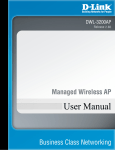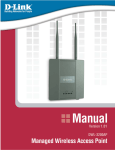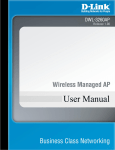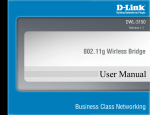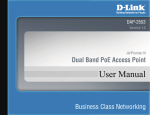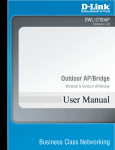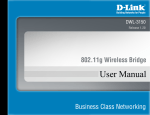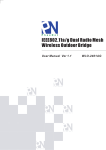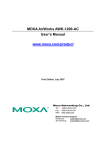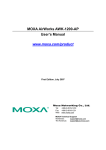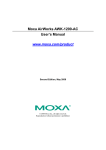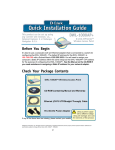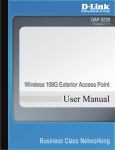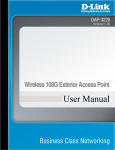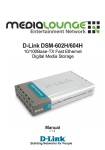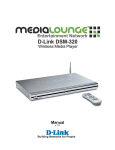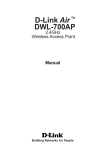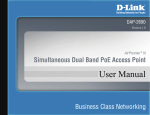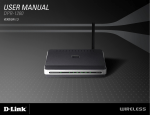Download Product Manual
Transcript
DWL-3200AP User’s Manual Table of Contents Table of Contents Table of Contents.............................................................................. 2 Package Contents............................................................................. 3 Introduction...................................................................................... 4 Features and Benefits........................................................................ 6 Wireless Basics................................................................................. 7 Three Operational Modes................................................................ 10 Getting Started................................................................................ 11 Using the Configuration Menu........................................................ 13 AP Manager II................................................................................. 54 Networking Basics.......................................................................... 55 Troubleshooting.............................................................................. 71 Technical Specifications.................................................................. 77 Contacting Technical Support......................................................... 80 Warranty ........................................................................................ 81 Registration ................................................................................... 83 D-Link Systems, Inc. DWL-3200AP User’s Manual Package Contents Package Contents D-Link AirPremierTM DWL-3200AP Managed Wireless Access Point Power over Ethernet base unit Power Adapter-DC 48V, 0.4A Power Cord Manual and Warranty on CD Quick Installation Guide Ethernet Cable Mounting Plate Note: Using a power supply with a different voltage than the one included with the DWL-3200AP will cause damage and void the warranty for this product. If any of the above items are missing, please contact your reseller. Minimum System Requirements Computers with Windows®, Macintosh®, or Linux-based operating systems with an installed Ethernet Adapter Internet Explorer version 6.0 or Netscape Navigator™ version 7.0 and above D-Link Systems, Inc. DWL-3200AP User’s Manual Introduction Introduction At up to fifteen times the speed of previous wireless devices (maximum wireless signal rate of up to 108Mbps* in Super G mode), you can work faster and more efficiently, increasing productivity. With the DWL-3200AP, bandwidth-intensive applications like graphics or multimedia will benefit significantly because large files are able to move across the network quickly. The DWL-3200AP is capable of operating in one of 3 different wireless networking modes; access point, WDS (Wireless Distribution System) with AP, or WDS mode. Use less wiring, enjoy increased flexibility, save time and money with PoE (Power over Ethernet). With PoE, the DWL-3200AP shares power and data over the CAT5 cable, making the setup of your network less expensive and more convenient. An ideal solution for quickly creating and extending a wireless local area network (WLAN) in offices or other workplaces, trade shows and special events, the DWL-3200AP provides data transfers at up to 108Mbps in Super G mode when used with other D-Link AirPremier products. (The 802.11g standard is backwards compatible with 802.11b devices.) WPA is offered in two flavors: Enterprise (used for corporations) and Personal (used for home users). WPA-Personal and WPA2-Personal is directed at home users who do not have the server based equipment required for user authentication. The method of authentication is similar to WEP because you define a “Pre-Shared Key” on the wireless router/AP. Once the pre-shared key is confirmed and satisfied on both the client and access point, then access is granted. The encryption method used is referred to as the Temporal Key Integrity Protocol (TKIP), which offers per-packet dynamic hashing. It also includes an integrity checking feature which ensures that the packets were not tampered with during wireless transmission. WPA2-Personal is far superior to WPA-Personal, because the encryption of data is upgraded with the Advanced Encryption Standard (AES). *”Maximum wireless signal rate derived from IEEE Standard 802.11g specifications. Actual data throughput will vary. Network conditions and environmental factors, including volume of network traffic, building materials and construction, and network overhead lower actual data throughout rate.” D-Link Systems, Inc. DWL-3200AP User’s Manual Introduction WPA-Enterprise and WPA2-Enterprise is ideal for businesses that have existing security infrastructures in place. Management and security implementation can now be centralized on a server participating on the network. Utilizing 802.1x with a RADIUS (Remote Authentication Dial-in User Service) server, a network administrator can define a list of authorized users who can access the wireless LAN. When attempting to access a wireless LAN with WPA-Enterprise or WPA2-Enterprise configured, the new client will be challenged with a username and password. If the new client is authorized by the administration, and enters the correct username and password, then access is granted. In a scenario where an employee leaves the company, the network administrator can remove the employee from the authorized list and not have to worry about the network being compromised by a former employee. WPA2-Enterprise is far superior to WPA-Enterprise, because the encryption of data is upgraded with the Advanced Encryption Standard (AES). 802.1x: Authentication which is a first line of defense against intrusion. In the authentication process, the Authentication Server verifies the identity of the client attempting to connect to the network. Unfamiliar clients would be denied access. EAP (Extensible Authentication Protocol) is available through the Windows® XP operating system. You will need to use the same type of EAP protocol on all devices in your network when using the 802.1x feature. D-Link Systems, Inc. DWL-3200AP User’s Manual Features and Benefits Features and Benefits 3 Different Operation modes - Capable of operating in one of three different operation modes to meet your wireless networking requirements: Access Point; WDS with AP, or WDS. Easy Installation with PoE (Power over Ethernet). Faster wireless networking with the 802.11g standard to provide a maximum wireless signal rate of up to 54Mbps* (maximum wireless signal rate of up to 108Mbps* in Super G mode). Compatible with the 802.11b standard to provide a wireless data rate of up to 11Mbps - that means you can migrate your system to the 802.11g standard on your own schedule without sacrificing connectivity. Better security with WPA - The DWL-3200AP can securely connect wireless clients on the network using WPA (Wi-Fi Protected Access) providing a much higher level of security for your data and communications than has previously been available. AP Manager II Setup Wizard - The new Setup Wizard makes network configuration quick and simple. SNMP for Management - The DWL-3200AP is not just fast but it also supports SNMP v.3 for a better network management. Superior wireless AP Manager II software is bundled with the DWL-3200AP for network configuration and firmware upgrade. Systems administrators can also setup the DWL-3200AP easily with the Web-based configuration. A D-Link D-View module will be downloadable for network administration and real-time network traffic monitoring with D-Link D-View software. Utilizes OFDM technology (Orthogonal Frequency Division Multiplexing). Operates in the 2.4GHz frequency range. Web-based interface for managing and configuring. *”Maximum wireless signal rate derived from IEEE Standard 802.11a and 802.11g specifications. Actual data throughput will vary. Network conditions and environmental factors, including volume of network traffic, building materials and construction, and network overhead lower actual data throughout rate.” D-Link Systems, Inc. DWL-3200AP User’s Manual Wireless Basics Wireless Basics D-Link wireless products are based on industry standards to provide easy-to-use and compatible high-speed wireless connectivity within your home, business or public access wireless networks. D-Link wireless products will allow you access to the data you want, when and where you want it. You will be able to enjoy the freedom that wireless networking brings. A Wireless Local Area Network (WLAN) is a computer network that transmits and receives data with radio signals instead of wires. WLANs are used increasingly in both home and office environments, and public areas such as airports, coffee shops and universities. Innovative ways to utilize WLAN technology are helping people to work and communicate more efficiently. Increased mobility and the absence of cabling and other fixed infrastructure have proven to be beneficial for many users. Wireless users can use the same applications they use on a wired network. Wireless adapter cards used on laptop and desktop systems support the same protocols as Ethernet adapter cards. People use WLAN technology for many different purposes: Mobility - Productivity increases when people have access to data in any location within the operating range of the WLAN. Management decisions based on real-time information can significantly improve worker efficiency. Low Implementation Costs - WLANs are easy to set up, manage, change and relocate. Networks that frequently change can benefit from WLANs ease of implementation. WLANs can operate in locations where installation of wiring may be impractical. Installation and Network Expansion - Installing a WLAN system can be fast and easy and can eliminate the need to pull cable through walls and ceilings. Wireless technology allows the network to go where wires cannot go - even outside the home or office. Inexpensive Solution - Wireless network devices are as competitively priced as conventional Ethernet network devices. The DWL-3200AP saves money by providing multi-functionality, configurable in one of four different modes. Scalability - WLANs can be configured in a variety of ways to meet the needs of specific applications and installations. Configurations are easily changed and range from Peer-to-Peer networks suitable for a small number of users to larger Infrastructure networks to accommodate hundreds or thousands of users, depending on the number of wireless devices deployed. D-Link Systems, Inc. DWL-3200AP User’s Manual Wireless Basics Standards-Based Technology The DWL-3200AP Managed Wireless Access Point utilizes the 802.11b and the 802.11g standards. The IEEE 802.11g standard is an extension of the 802.11b standard. It increases the maximum wireless signal rate of up to 54Mbps* (maximum wireless signal rate of up to 108Mbps* in Super G mode) within the 2.4GHz band, utilizing OFDM technology. This means that in most environments, within the specified range of this device, you will be able to transfer large files quickly or even watch a movie in MPEG format over your network without noticeable delays. This technology works by transmitting high-speed digital data over a radio wave utilizing OFDM (Orthogonal Frequency Division Multiplexing) technology. OFDM works by splitting the radio signal into multiple smaller sub-signals that are then transmitted simultaneously at different frequencies to the receiver. OFDM reduces the amount of crosstalk (interference) in signal transmissions. The D-Link DWL-3200AP will automatically sense the best possible connection speed to ensure the greatest speed and range possible. 802.11g offers the most advanced network security features available today, including WPA and WPA2. *”Maximum wireless signal rate derived from IEEE Standard 802.11g specifications. Actual data throughput will vary. Network conditions and environmental factors, including volume of network traffic, building materials and construction, and network overhead lower actual data throughout rate.” D-Link Systems, Inc. DWL-3200AP User’s Manual Wireless Basics Installation Considerations The D-Link AirPremier DWL-3200AP lets you access your network, using a wireless connection, from virtually anywhere within its operating range. Keep in mind, however, that the number, thickness and location of walls, ceilings, or other objects that the wireless signals must pass through, may limit the range. Typical ranges vary depending on the types of materials and background RF (radio frequency) noise in your home or business. The key to maximizing wireless range is to follow these basic guidelines: 1 Keep the number of walls and ceilings between the DWL-3200AP and other network devices to a minimum - each wall or ceiling can reduce your DWL-3200AP’s range from 3-90 feet (1-30 meters.) Position your devices so that the number of walls or ceilings is minimized. 2 Be aware of the direct line between network devices. A wall that is 1.5 feet thick (.5 meters), at a 45-degree angle appears to be almost 3 feet (1 meter) thick. At a 2-degree angle it looks over 42 feet (14 meters) thick! Position devices so that the signal will travel straight through a wall or ceiling (instead of at an angle) for better reception. 3 Building materials can impede the wireless signal - a solid metal door or aluminum studs may have a negative effect on range. Try to position wireless devices and computers with wireless adapters so that the signal passes through drywall or open doorways and not other materials. 4 Keep your product away (at least 3-6 feet or 1-2 meters) from electrical devices or appliances that generate RF noise. D-Link Systems, Inc. DWL-3200AP User’s Manual Three Operational Modes Three Operational Modes D-Link Systems, Inc. 10 DWL-3200AP User’s Manual Getting Started Getting Started 1 You will need broadband Internet access. 2 Consult with your Cable or DSL provider for proper installation of the modem. 3 Connect the Cable or DSL modem to a Router. (See the printed Quick Installation Guide included with your router.) 4 Connect the Ethernet Broadband Router to the PoE base unit. (See the printed Quick Installation Guide included with the DWL-3200AP.) 5 Connect the DWL-3200AP to the PoE base unit. (See the printed Quick Installation Guide included with the DWL-3200AP.) 6 If you are connecting a desktop computer to your network, install the D-Link WDA-2320 wireless PCI adapter into an available PCI slot on your desktop computer. (See the printed Quick Installation Guide included with the network adapter.) 7 Install the drivers for the D-Link WNA-2330 wireless Cardbus adapter into a laptop computer. (See the printed Quick Installation Guide included with the WNA-2330.) D-Link Systems, Inc. 11 DWL-3200AP User’s Manual Getting Started Connecting PoE (Power over Ethernet) Step 1 Connect one end of an Ethernet cable (included with your package) to the LAN port on the DWL-3200AP and the other end of the Ethernet cable to the port labeled P+DATA OUT on the PoE base unit. Step 2 Connect another Ethernet cable from the DATA IN port on the PoE base unit to your router/switch, using a straight through cable, or to a PC, using a crossover cable. Step 3 Attach the power adapter to the connector labeled POWER IN on the PoE base unit. Attach the power cord to the power adapter and into an electrical outlet. D-Link Systems, Inc. 12 DWL-3200AP User’s Manual Using the Configuration Menu Using the Configuration Menu To configure the DWL-3200AP, use a computer which is connected to the DWL-3200AP with an Ethernet cable (see the Network Layout diagram). First, disable the Access the Internet using a proxy server function. To disable this function, go to Control Panel > Internet Options > Connections > LAN Settings and uncheck the enable box. Start your web browser program (Internet Explorer, Netscape Navigator™) . Type the IP address and http port of the DWL-3200AP in the address field (http://192.168.0.50) and press Enter. Make sure that the IP addresses of the DWL-3200AP and your computer are in the same subnet. After the connection is established, you will see the user identification window as shown. Note: If you have changed the default IP address assigned to the DWL-3200AP, make sure to enter the correct IP address. Type admin in the User Name field Leave the Password field blank Click OK Note: If you have changed the password, make sure to enter the correct password. D-Link Systems, Inc. 13 DWL-3200AP User’s Manual Using the Configuration Menu After successfully logging into the DWL-3200AP the following screen appears: When making changes on most of the configuration screens in this section, use the Apply button at the bottom of each screen to save your configuration changes. Click to apply configuration changes. D-Link Systems, Inc. 14 DWL-3200AP User’s Manual Using the Configuration Menu Home > Basic Settings > Wireless Wireless Band: IEEE 802.11g Mode: Access Point is selected from the pull-down menu. SSID: Service Set Identifier (SSID) is the name designated for a specific wireless local area network (WLAN). The SSID’s factory default setting is dlink. The SSID can be easily changed to connect to an existing wireless network or to establish a new wireless network. The SSID can be up to 32 characters and is case-sensitive. SSID Broadcast: Enable or Disable SSID broadcast. Enabling this feature broadcasts the SSID across the network. Channel: Auto Channel Scan is set by default. All devices on the network must share the same channel. To change the channel, uncheck Auto Channel Scan. (Note: The wireless adapters will automatically scan and match the wireless setting.) D-Link Systems, Inc. 15 Using the Configuration Menu DWL-3200AP User’s Manual Home > Basic Settings > Wireless (continued) Auto Channel Scan: Authentication: Select Enable or Disable. (Enable this feature to auto-select the channel for best wireless performance.) Open System Shared Key Open System/Shared Key WPA-Enterprise WPA-Personal WPA2-Enterprise WPA2-Personal WPA-Auto-Enterprise WPA-Auto-Personal Select Open System to communicate the key across the network. Select Shared Key to limit communication to only those devices that share the same WEP settings. Select Open System/Shared Key to allow either form of data encryption. Select WPA-Enterprise, WPA2-Enterprise, WPA-Auto-Enterprise to secure your network with the inclusion of a RADIUS server. Select WPA-Personal, WPA2-Personal, WPA-Auto-Personal to secure your network using a password and dynamic key changes. (No RADIUS server required). Encryption: Select Disabled or Enabled. (Disabled is selected here). Key Type*: Select HEX or ASCII. Key Size: Select 64-, 128-, 152-bits. Valid Key: First through Fourth keys: Select the 1st through the 4th key to be the active key. Input up to four keys for encryption. You will select one of these keys in the valid key field. *Hexadecimal digits consist of the numbers 0-9 and the letters A-F *ASCII (American Standard Code for Information Interchange) is a code for representing English letters as numbers from 0-127 D-Link Systems, Inc. 16 DWL-3200AP User’s Manual Using the Configuration Menu Home > Basic Settings > Wireless > WPA-Enterprise, WPA2-Enterprise, & WPA-Auto-Enterprise Cipher Type: When you select WPA-Enterprise, you must select AUTO, AES, or TKIP from the pull down menu. Group Key Update Select the interval during which the group key will be valid. Interval: 1800 is the recommended value. A lower interval may reduce data transfer rate. RADIUS Server: Enter the IP address of the RADIUS server. RADIUS Port: Enter the RADIUS port. RADIUS Secret: Enter the RADIUS secret. Accounting Mode: Select if you want to use a different server for accounting. Accounting Server: Enter the IP address of the Accounting server. Accounting Port: Enter the Accounting port (1813 is default). D-Link Systems, Inc. 17 DWL-3200AP User’s Manual Using the Configuration Menu Home > Basic Settings > Wireless > WPA-Personal, WPA2-Personal, & WPA-Auto-Personal Cipher Type: When you select WPA-Personal, please select AUTO, AES, or TKIP from the pull down menu. Group Key Update Select the interval during which the group key will be valid. The Interval: default value of 1800 is recommended. PassPhrase: When you select WPA-Personal, please enter a PassPhrase in the corresponding field. D-Link Systems, Inc. 18 DWL-3200AP User’s Manual Using the Configuration Menu Home > Basic Settings > Wireless > WDS with AP mode In WDS with AP mode, the DWL-3200AP wirelessly connects multiple networks, while still functioning as a wireless AP. Wireless Band: IEEE 802.11g Mode: WDS with AP mode is selected from the pull-down menu. SSID: Service Set Identifier (SSID) is the name designated for a specific wireless local area network (WLAN). The SSID’s factory default setting is dlink. The SSID can be easily changed to connect to an existing wireless network or to establish a new wireless network. SSID Broadcast: Enable or Disable SSID broadcast. Enabling this feature broadcasts the SSID across the network. D-Link Systems, Inc. 19 Using the Configuration Menu DWL-3200AP User’s Manual Home > Basic Settings > Wireless > WDS with AP (continued) Channel: 6 is the default channel. All devices on the network must share the same channel. (Note: The wireless adapters will automatically scan and match the wireless setting.) Auto Channel Click on the Scan button to search for available wireless networks. Scan: Click on the network you want to connect to. Remote AP MAC Select Enable or Disable. (Enable this feature to auto-select the Address: channel for best wireless performance.) WDS Site Survey: Enter the MAC addresses of the APs in your network that will serve as bridges to wirelessly connect multiple networks. Authentication: Open System Shared Key Open System/Shared Key WPA-Personal WPA2-Personal WPA-Auto-Personal Select Open System to communicate the key across the network. Select Shared Key to limit communication to only those devices that share the same WEP settings. Select Open System/Shared Key to allow either form of data encryption. Select WPA-Personal, WPA2-Personal, or WPA-Auto-Personal to secure your network using a password and dynamic key changes. (No RADIUS Server required). D-Link Systems, Inc. 20 DWL-3200AP User’s Manual Using the Configuration Menu Home > Basic Settings > Wireless > WDS mode In WDS mode, the DWL-3200AP wirelessly connects multiple networks, without functioning as a wireless AP. Wireless Band: IEEE 802.11g Mode: WDS is selected from the pull-down menu. SSID: Service Set Identifier (SSID) is the name designated for a specific wireless local area network (WLAN). The SSID’s factory default setting is default. The SSID can be easily changed to connect to an existing wireless network or to establish a new wireless network. SSID Broadcast: Enable or Disable SSID broadcast. Enabling this feature broadcasts the SSID across the network. D-Link Systems, Inc. 21 Using the Configuration Menu DWL-3200AP User’s Manual Channel: 6 is the default channel. All devices on the network must share the same channel. Auto Channel Select Enable or Disable. (Enable this feature to auto-select the Scan: channel for best wireless performance.) Remote AP MAC Enter the MAC addresses of the APs in your network that will serve Address: as bridges to wirelessly connect multiple networks. WDS Site Survey: Click on the Scan button to search for available wireless networks. Click on the network you want to connect to. Authentication: Open System Shared Key Open System/Shared Key WPA-Personal WPA2-Personal WPA-Auto-Personal Select Open System to communicate the key across the network. Select Shared Key to limit communication to only those devices that share the same WEP settings. Select Open System/Shared Key to allow either form of data encryption. Select WPA-Personal, WPA2-Personal, or WPA-Auto-Personal to secure your network using a password and dynamic key changes. (No RADIUS Server required). D-Link Systems, Inc. 22 Using the Configuration Menu DWL-3200AP User’s Manual Home > Wireless Modes AP Mode Authentication Available Access Point Open System Shared Key Open System/Shared Key WPA-Enterprise WPA-Personal WPA2-Enterprise WPA2-Personal WPA-Auto-Enterprise WPA-Auto-Personal WDS with AP Open System Shared Key Open System/Shared Key WPA-Personal WPA2-Personal WPA-Auto-Personal WDS Open System Shared Key Open System/Shared Key WPA-Personal WPA2-Personal WPA-Auto-Personal D-Link Systems, Inc. 23 DWL-3200AP User’s Manual Using the Configuration Menu Home > Basic Settings > LAN LAN is short for Local Area Network. This is considered your internal network. These are the IP settings of the LAN interface for the DWL-3200AP. These settings may be referred to as private settings. You may change the LAN IP address if needed. The LAN IP address is private to your internal network and cannot be seen on the Internet. Get IP From: Static (Manual) is chosen here. Choose this option if you do not have a DHCP server in your network, or if you wish to assign a static IP address to the DWL-3200AP. When DHCP is selected the other fields here will be greyed out. IP Address: The default IP address is 192.168.0.50. Assign a static IP address that is within the IP address range of your network. Subnet Mask: Enter the subnet mask. All devices in the network must share the same subnet mask. Default Gateway: Enter the IP address of the gateway in your network. If there isn’t a gateway in your network, please enter an IP address within the range of your network. D-Link Systems, Inc. 24 DWL-3200AP User’s Manual Using the Configuration Menu Home > Advanced Settings > Performance Wireless Band: IEEE 802.11g. Frequency: The frequency reflects the choice of the wireless channel. When IEEE 802.11g is chosen the frequency is 2.437GHz for channel 6. Channel: The default channel for IEEE 802.11g is 6. Data Rate*: The Data Rates are Auto, 6Mbps, 9Mbps, 12Mbps, 18Mbps, 24Mbps, 36Mbps, 48Mbps, 54Mbps. Beacon Interval: Beacons are packets sent by an access point to synchronize a network. Specify a beacon interval value. The default (100) is recommended. DTIM: (Delivery Traffic Indication Message) - Select a setting between 1 and 255. 1 is the default setting. DTIM is a countdown informing clients of the next window for listening to broadcast and multicast messages. *”Maximum wireless signal rate based on IEEE Standard 802.11a and 802.11g specifications. Actual data throughput will vary. Network conditions and environmental factors, including volume of network traffic, building materials and construction, and network overhead lower actual data throughout rate.” D-Link Systems, Inc. 25 Using the Configuration Menu DWL-3200AP User’s Manual Fragment Length: The fragmentation threshold, which is specified in bytes, determines whether packets will be fragmented. Packets exceeding the 2346 byte setting will be fragmented before transmission. 2346 is the default setting RTS Length: This value should remain at its default setting of 2346. If you encounter inconsistent data flow, only minor modifications to the value range between 256 and 2346 are recommended Transmit Power: Choose full, half (-3dB), quarter (-6dB), eighth (-9dB), minimum power. Super G Mode: Super G is a group of performance enhancement features that increase end user application throughput in an 802.11g network. Super G is backwards compatible to standard 802.11g devices. For top performance, all wireless devices on the network should be Super G capable. Select either Disabled, Super G without Turbo, or Super G with Dynamic Turbo. Disabled: Standard 802.11g support, no enhanced capabilities. Super G without Capable of Packet Bursting, FastFrames, Compression, Turbo: and no Turbo mode. Super G with Dynamic Turbo: Capable of Packet Bursting, FastFrames, Compression, and Dynamic Turbo. This setting is backwards compatible with non-Turbo (legacy) devices. Dynamic Turbo mode is only enabled when all devices on the wireless network are configured with Super G with Dynamic Turbo enabled. Radio: Select On or Off. WMM: Select Enable or Disable, Disable is selected by default. WMM stands for Wi-Fi Multimedia, by enabling this feature it will improve the user experience for audio and video applications over a Wi-Fi network. Praemble: Select the default value Short and Long, or Long Only. Wireless B/G Mode: This function allows you to configure the wireless network with IEEE 802.11g only, IEEE 802.11b only, or IEEE 802.11g with backward interoperability with IEEE 802.11b. Antenna Diversity: The DWL-3200AP supports 2.4GHz radio with two antennas. Radio is connected to each antenna and supports auto diversity mode by default. This means that the access point will auto switch to the antenna with better RSSI value. D-Link Systems, Inc. 26 DWL-3200AP User’s Manual Antenna Diversity Diversity: The DWL-3200AP will auto switch to the antenna with (continued): better RSSI value. Left Antenna: The AP will not switch antenna and the radio will use the left antenna (when facing the AP) to transmit and receive packets. Right Antenna: AP won’t switch antenna and the radio will use the right antenna (when facing the AP) to transmit and receive packets. D-Link Systems, Inc. 27 DWL-3200AP User’s Manual Using the Configuration Menu Home > Advanced Settings > Grouping Load Balance: Load Balancing allows you to balance and share the wireless network traffic and clients using multiple DWL-3200APs. Select Enable or Disable. User Limit: Sets the maximum amount of users allowed (0-64). Link Integrate: If the Ethernet connection between the LAN and the DWL-3200AP is disconnected, the Link Integrate option will cause the wireless segment associated with the AP to be disconnected from the AP. Select Enable or Disable. Ethernet Link Displays the current link status of the DWL-3200AP Ethernet port. Status: D-Link Systems, Inc. 28 DWL-3200AP User’s Manual Using the Configuration Menu Home > Advanced Settings > Multi-SSID If you want to configure the Guest and Internal networks on Virtual LAN (VLANs), the switch and DHCP server you are using must support VLANs. As a prerequisite step, configure a port on the switch for handling VLAN tagged packets as described in the IEEE802.1Q standard. Enable Multi-SSID: Check to use Multi-SSID. Enable VLAN Status: Check to use a VLAN. Band: IEEE802.11g is selected. Index: You can select up to 7 multi-SSIDs. The default multi-SSIDs is the primary, which puts the total to 8 multi-SSIDs. SSID: Service Set Identifier (SSID) is the name designated for a specific wireless local area network (WLAN). The SSID’s factory default setting is default. The SSID can be easily changed to connect to an existing wireless network or to establish a new wireless network. D-Link Systems, Inc. 29 DWL-3200AP User’s Manual Security: The Multi-SSIDs security can be WPA/WPA2-Enterprise or WPA-Auto-Enterprise only when the Primary SSID’s security is at the same security level. Also, they must connect to the same RADIUS server. VLAN ID: If you configure enable Guest access and configure Internal and Guest networks on VLANs, this field will be enabled. Provide a number between 1 and 4094 for the Internal VLAN. This will cause the access point to send DHCP requests with the VLAN tag. The switch and the DHCP server must support VLAN IEEE802.1Q frames. The access point must be able to reach the DHCP server. Check with the Administrator regarding the VLAN and DHCP configurations. Key Type: Select HEX or ASCII. Key Size: Select 64-bit, 128-bit, or 152-bit. Key: Select the 1st key all the way through the 4th key, to be set as the active key. Enter key here. When Primary SSID is set to any of the following security levels: None Open System (WEP) Shared Key (WEP) WPA-Personal WPA2-Personal WPA-Auto-Personal WPA-Enterprise WPA2-Enterprise WPA-Auto-Enterprise D-Link Systems, Inc. Multi-SSID can use any of these security levels: None Open System (WEP) Shared Key (WEP) WPA-Personal WPA2-Personal WPA-Auto-Personal None Open System (WEP) Shared Key (WEP) WPA-Personal WPA2-Personal WPA-Auto-Personal WPA-Enterprise WPA2-Enterprise WPA-Auto-Enterprise 30 DWL-3200AP User’s Manual Note: If WPA or WPA2 is being used, it will occupy the key space 2 and 3, which will leave key 1 and 4 for other SSIDs to use for WEP. When you configure one Multi-SSID, you must click Save to Table and then click Apply to save your settings. Cipher Type: When you select WPA-Personal, please select AUTO, AES, or TKIP from the pull down menu. Group Key Update Select the interval during which the group key will be valid. The Interval: default value of 1800 is recommended. PassPhrase: When you select WPA-Personal, please enter a PassPhrase in the corresponding field. D-Link Systems, Inc. 31 DWL-3200AP User’s Manual Using the Configuration Menu Home > Advanced Settings > Rogue AP BSS Type: The Basic Service Set Type allows you to select from AP BSS, Ad Hoc, or Both. Band: Select the type of network (bands 11b and 11g) that you would like the AP detection to search on. D-Link Systems, Inc. 32 DWL-3200AP User’s Manual Using the Configuration Menu Security: Select the Security type OFF, WEP, WPA-Enterprise, WPA-Personal, WPA2-Enterprise, WPA2-Personal, WPA-Auto-Enterprise, and WPA-Auto-Personal that you would like to consider during AP detection. Rogue AP List: This window shows all of the neighbor APs detected, which is based on your criteria from above (BSS Type, Band, and Security). If the AP is in the same network, or if you know the AP, just click on “Add” to save it to the AP list. AP List: This window shows all of the APs that are allowed access on the network. D-Link Systems, Inc. 33 DWL-3200AP User’s Manual Using the Configuration Menu Home > Advanced Settings > DHCP Server > Dynamic Pool Settings DHCP Server Dynamic Host Configuration Protocol assigns dynamic IP Control: addresses to devices on the network. This protocol simplifies network management and allows new wireless devices to receive IP addresses automatically without the need to manually assign new IP addresses. Select Enable to allow the DWL-3200AP to function as a DHCP server. IP Assigned From: Input the first IP address available for assignment in your network. The Range of Pool Enter the number of IP addresses available for assignment. (1-255): SubMask: All devices in the network must have the same subnet mask to communicate. Enter the submask for the network here. D-Link Systems, Inc. 34 DWL-3200AP User’s Manual Using the Configuration Menu Gateway: Enter the IP address of the gateway on the network. Wins: Windows Internet Naming Service is a system that determines the IP address of a network computer that has a dynamically assigned IP address. DNS: Enter the IP address of the DNS server. The DNS (Domain Name Server) translates domain names such as www.dlink.com into IP addresses. Domain Name: Enter the domain name of the DWL-3200AP, if applicable. (An example of a domain name is: www.dlink.com.) Lease Time The Lease Time is the period of time before the DHCP server will (60-31536000 sec.): assign new IP addresses. Status: Turn the Dynamic Pool Settings ON or OFF here. D-Link Systems, Inc. 35 DWL-3200AP User’s Manual Using the Configuration Menu Home > Advanced Settings > DHCP Server > Static Pool Settings DHCP Server Dynamic Host Configuration Protocol assigns IP addresses to Control: wireless devices on the network. This protocol simplifies network management and allows new wireless devices to receive IP addresses automatically without the need to manually assign IP addresses. Select Enable to allow the DWL-3200AP to function as a DHCP server. Assigned IP: Use the Static Pool Settings to assign the same IP address to a device at every restart. The IP addresses assigned in the Static Pool list must NOT be in the same IP range as the Dynamic Pool. After you have assigned a static IP address to a device via its MAC address, click Apply; the device will appear in the Assigned Static Pool at the bottom of the screen. Edit or delete the device in this list. Assigned MAC Enter the MAC address of the device here. Address: SubMask: Enter the subnet mask here. D-Link Systems, Inc. 36 DWL-3200AP User’s Manual Using the Configuration Menu Gateway: Enter the IP address of the gateway on the network. Wins: Windows Internet Naming Service is a system that determines the IP address of a network computer with a dynamically assigned IP address, if applicable. DNS: Enter the IP address of the Domain Name Server, if applicable. The DNS translates domain names such as www.dlink.com into IP addresses. Domain Name: Enter the domain name of the DWL-3200AP, if applicable. Status: This option turns the Static Pool settings ON or OFF. D-Link Systems, Inc. 37 DWL-3200AP User’s Manual Using the Configuration Menu Home > Advanced Settings > DHCP Server > Current IP Mapping List This screen displays information about the current DHCP dynamic and static IP address pools. This information is available when you enable the DHCP function of the DWL-3200AP and assign dynamic and static IP address pools. Current DHCP These are IP address pools to which the DHCP server function has Dynamic Pools: assigned dynamic IP addresses. Binding MAC The MAC address of a device on the network that is within the DHCP address: dynamic IP address pool. Assigned IP address: The current corresponding DHCP-assigned dynamic IP address of the device. Lease Time: The length of time that the dynamic IP address will be valid. Current DHCP Static These are IP address pools to which the DHCP server function has Pools: assigned static IP addresses. D-Link Systems, Inc. 38 DWL-3200AP User’s Manual Using the Configuration Menu Binding MAC The MAC address of a device on the network that is within the DHCP address: static IP address pool. Assigned IP The current corresponding DHCP-assigned static IP address of the address: device. D-Link Systems, Inc. 39 DWL-3200AP User’s Manual Using the Configuration Menu Home > Advanced Settings >Filters > Wireless MAC ACL Wireless Band: IEEE 802.11g Access Control: Select Disabled to disable the filters function. Select Accept to accept only those devices with MAC addresses in the Access Control List. Select Reject to reject the devices with MAC addresses in the Access Control List. MAC Address: Enter the MAC addresses that you wish to include in your filters list, and click Save. MAC Address List: When you enter a MAC address, it appears in this list. Highlight a MAC address and click Delete to remove it from the list. D-Link Systems, Inc. 40 DWL-3200AP User’s Manual Using the Configuration Menu Home > Advanced Settings >Filters > WLAN Partition Wireless Band: IEEE 802.11g Internal Station Enabling this feature allows wireless clients to communicate with Connection: each other. If this is disabled, wireless stations of the selected band are not allowed to exchange data through the access point. Ethernet to WLAN Enabling this feature allows Ethernet devices to communicate with Access: wireless clients. If this is disabled, all data from the Ethernet to associated wireless devices is blocked. Wireless devices can still send data to the Ethernet. D-Link Systems, Inc. 41 DWL-3200AP User’s Manual Using the Configuration Menu Home > Status > Device Information Device Information: This window displays the configuration settings of the DWL-3200AP, including the firmware version and device MAC address. D-Link Systems, Inc. 42 DWL-3200AP User’s Manual Using the Configuration Menu Home > Status > Client Information Client Information: This window displays the wireless client information for clients currently connected to the DWL-3200AP. The following infor mation is available for each client communicating with the DWL-3200AP. MAC: Displays the MAC address of the client. Band: Displays the wireless band the client is connected on. Authentication: Displays the type of authentication being used. Signal: Displays the strength of the clients signal. Power Saving Displays the status of the power saving feature. Mode: D-Link Systems, Inc. 43 DWL-3200AP User’s Manual Using the Configuration Menu Home > Status > Log > View Log View Log: The log displays system and network messages including a time stamp and message type. D-Link Systems, Inc. 44 DWL-3200AP User’s Manual Using the Configuration Menu Home > Status > Log > Log Settings Log Settings Log Server / IP Enter the IP address of the server you would like to send the Address: DWL-3200APs log to. Log Type: Check the box for the type of activity you want to log. There are three types: System, Wireless and Notice. SMTP Settings SMTP: Check the box to enable SMTP. SMTP Server / IP Enter the IP address of the SMTP server. Address: SMTP Sender: Enter the e-mail address of the SMTP sender. SMTP Recipient: Enter the e-mail address of the SMTP recipient. D-Link Systems, Inc. 45 DWL-3200AP User’s Manual Using the Configuration Menu Tool > Administrator Settings Limit Check the box to enable the feature. Administrator IP Limit Administrator Enter the IP address that the administrator will be allowed to log IP 1: in from. Limit Administrator Enter a secondary IP address that the administrator will be allowed IP 2: to log in from. Login Settings User Name: Enter a user name. The default is admin. Old Password: When changing your password, enter the old password here. New Password: When changing your password, enter the new password here. Confirm New Confirm your new password here. Password: D-Link Systems, Inc. 46 DWL-3200AP User’s Manual Using the Configuration Menu Console Settings Status: Status is Enabled by default. Uncheck the box to disable the console. Console Protocol: Select the type of protocol you would like to use, Telnet or SSH. SNMP Settings Status: Status is Enabled by default. Uncheck the box to disable the SNMP functions. Public Community Enter the public SNMP community string. String: Private Community Enter the private SNMP community string. String: D-Link Systems, Inc. 47 DWL-3200AP User’s Manual Tool > Firmware and SSL Certification Upload Upload Firmware After downloading the most recent version of firmware for the DWL-3200AP from http://support.dlink.com to your local computer, use the Browse button to locate the firmware file on your computer. Click Upload to update the firmware version. Upload SSL Click Browse to locate the SSL Certification file on your local Certification: computer. After selecting and opening the file, click Upload to upload the file to the DWL-3200AP. D-Link Systems, Inc. 48 DWL-3200AP User’s Manual Using the Configuration Menu Tool > Configuration File Upload and Download Upload File: Click Browse to locate a previously saved configuration file on your local computer. After selecting the file, click Upload to apply the configuration settings to the DWL-3200AP. Download Click Download to save the current DWL-3200AP configuration Configuration File: to your local computer. D-Link Systems, Inc. 49 DWL-3200AP User’s Manual Using the Configuration Menu Tools > Cfg File > Choose file When you click Browse in the previous screen, the dialog box shown above appears. Select the file you wish to download and click Open. Click OK to begin loading. Click Restart for the settings to take effect. The dialog box above will appear as the device restarts. Please wait for a few seconds. D-Link Systems, Inc. 50 DWL-3200AP User’s Manual Using the Configuration Menu Tool > SNTP SNTP/NTP Information: SNT/NTP Server IP Address: SNTP/NTP Time Zone: Daylight Saving Time: D-Link Systems, Inc. Displays the current SNTP/NTP settings. Enter the SNTP/NTP server IP address. Select your correct Time Zone. Check the box to Enable Daylight Saving Time. 51 DWL-3200AP User’s Manual Using the Configuration Menu System > System Settings Click Restart to restart the DWL-3200AP. Click Restore to restore the DWL-3200AP back to factory default settings. D-Link Systems, Inc. 52 DWL-3200AP User’s Manual Using the Configuration Menu Help Help: Scroll down the Help page for topics and explanations. D-Link Systems, Inc. 53 DWL-3200AP User’s Manual AP Manager II AP Manager II AP Manager II is a convenient software tool used to manage the configuration of your wireless network from a central computer. With AP Manager II there is no need to configure devices individually. AP Manager II allows you to configure AP settings, update the firmware, and organize and sort your APs into manageable groups. Please see the AP Manager II User Manual included on the CD for system requirements, installation considerations, and information on the software functionality. D-Link Systems, Inc. 54 DWL-3200AP User’s Manual Networking Basics Networking Basics Using the Network Setup Wizard in Windows® XP In this section you will learn how to establish a network at home or work, using Microsoft Windows® XP. Note: Please refer to websites such as http://www.homenethelp.com and http://www.microsoft.com/windows2000 for information about networking computers using Windows® 2000. Go to Start>Control Panel>Network Connections Select Set up a home or small office network When this screen appears, click Next. D-Link Systems, Inc. 55 DWL-3200AP User’s Manual Networking Basics Please follow all the instructions in this window: Click Next. In the following window, select the best description of your computer. If your computer connects to the internet through a gateway/router, select the second option as shown. Click Next. D-Link Systems, Inc. 56 DWL-3200AP User’s Manual Networking Basics Enter a Computer description and a Computer name (optional). Click Next. Enter a Workgroup name. All computers on your network should have the same Workgroup name. Click Next. D-Link Systems, Inc. 57 DWL-3200AP User’s Manual Networking Basics Please wait while the Network Setup Wizard applies the changes. When the changes are complete, click Next. Please wait while the Network Setup Wizard configures the computer. This may take a few minutes. D-Link Systems, Inc. 58 DWL-3200AP User’s Manual Networking Basics In the window below, select the option that fits your needs. In this example, Create a Network Setup Disk has been selected. You will run this disk on each of the computers on your network. Click Next. Insert a disk into the Floppy Disk Drive, in this case drive A. Click Next. D-Link Systems, Inc. 59 DWL-3200AP User’s Manual Networking Basics Please read the information under Here’s how in the screen below. After you complete the Network Setup Wizard you will use the Network Setup Disk to run the Network Setup Wizard once on each of the computers on your network. To continue click Next. D-Link Systems, Inc. 60 DWL-3200AP User’s Manual Networking Basics Please read the information on this screen, then click Finish to complete the Network Setup Wizard. The new settings will take effect when you restart the computer. Click Yes to restart the computer. You have completed configuring this computer. Next, you will need to run the Network Setup Disk on all the other computers on your network. After running the Network Setup Disk on all your computers, your new wireless network will be ready to use. D-Link Systems, Inc. 61 DWL-3200AP User’s Manual Networking Basics Naming Your Computer To name your computer in Windows® XP, please follow these directions. Click Start (in the lower left corner of the screen). Right-click on My Computer. Select Properties and click. Select the Computer Name Tab in the System Properties window. You may enter a Computer Description if you wish; this field is optional. To rename the computer and join a domain, Click Change. D-Link Systems, Inc. 62 DWL-3200AP User’s Manual Networking Basics In this window, enter the Computer name. Select Workgroup and enter the name of the Workgroup. All computers on your network must have the same Workgroup name. Click OK. Checking the IP Address in Windows® XP The wireless adapter-equipped computers in your network must be in the same IP Address range (see Getting Started in this manual for a definition of IP Address Range.) To check on the IP Address of the adapter, please do the following: Right-click on the Local Area Connection icon in the task bar. Click on Status. D-Link Systems, Inc. 63 DWL-3200AP User’s Manual Networking Basics This window will appear: Click the Support tab. Click Close. D-Link Systems, Inc. 64 DWL-3200AP User’s Manual Networking Basics Assigning a Static IP Address in Windows® XP/2000 Note: DHCP-enabled routers will automatically assign IP addresses to the computers on the network, using DHCP (Dynamic Host Configuration Protocol) technology. If you are using a DHCP-capable router you will not need to assign static IP addresses. If you are not using a DHCP capable router, or you need to assign a static IP address, please follow these instructions: Go to Start. Double-click on Control Panel. Double-click on Network Connections. D-Link Systems, Inc. 65 DWL-3200AP User’s Manual Networking Basics Right-click on Local Area Connections. Double-click on Properties. Click on Internet Protocol (TCP/IP). Click Properties. Input your IP address and subnet mask. (The IP addresses on your network must be within the same range. For example, if one computer has an IP address of 192.168.0.2, the other computers should have IP addresses that are sequential, like 192.168.0.3 and 192.168.0.4. The subnet mask must be the same for all the computers on the network.) D-Link Systems, Inc. 66 DWL-3200AP User’s Manual Networking Basics Input your DNS server addresses. (Note: If you are entering a DNS server, you must enter the IP address of the default gateway.) The DNS server information will be supplied by your ISP (Internet Service Provider.) Click OK. Assigning a Static IP Address in Macintosh® OSX Go to the Apple Menu and select System Preferences. Click on Network. D-Link Systems, Inc. 67 DWL-3200AP User’s Manual Networking Basics Select Built-in Ethernet in the Show pull-down menu. Select Manually in the Configure pull-down menu. Input the Static IP Address, the Subnet Mask and the Router IP Address in the appropriate fields. Click Apply Now. D-Link Systems, Inc. 68 DWL-3200AP User’s Manual Networking Basics Go to the Apple Menu and select System Preferences. Click on Network. Select Built-in Ethernet in the Show pull-down menu. Select Using DHCP in the Configure pull-down menu. D-Link Systems, Inc. 69 DWL-3200AP User’s Manual Networking Basics Click Apply Now. The IP Address, Subnet mask, and the Router’s IP Address will appear in a few seconds. Checking the Wireless Connection by Pinging in Windows® XP and 2000 Go to Start > Run > type cmd. A window similar to this one will appear. Type ping xxx.xxx. xxx.xxx, where xxx is the IP address of the wireless router or access point. A good wireless connection will show four replies from the wireless router or access point, as shown. D-Link Systems, Inc. 70 DWL-3200AP User’s Manual Troubleshooting Troubleshooting This Chapter provides solutions to problems that can occur during the installation and operation of the DWL-3200AP Managed Wireless Access Point. We cover various aspects of the network setup, including the network adapters. Please read the following if you are having problems. Note: It is recommended that you use an Ethernet connection to configure the DWL-3200AP . 1. The computer used to configure the DWL-3200AP cannot access the Configuration menu. Check that the Ethernet LED on the DWL-3200AP is ON. If the LED is not ON, check that the cable for the Ethernet connection is securely inserted. Check that the Ethernet Adapter is working properly. Please see item 3 (Check that the drivers for the network adapters are installed properly) in this Troubleshooting section to check that the drivers are loaded properly. Check that the IP address is in the same range and subnet as the DWL-3200AP. Please see Checking the IP Address in Windows® XP in the Networking Basics section of this manual. Note: The IP address of the DWL-3200AP is 192.168.0.50. All the computers on the network must have a unique IP address in the same range, e.g., 192.168.0.x. Any computers that have identical IP addresses will not be visible on the network. They must all have the same subnet mask, e.g., 255.255.255.0. Do a Ping test to make sure that the DWL-3200AP is responding. Go to Start>Run>Type Command>Type ping 192.168.0.50. A successful ping will show four replies. Note: If you have changed the default IP address, make sure to ping the correct IP address assigned to the DWL-3200AP. D-Link Systems, Inc. 71 DWL-3200AP User’s Manual Troubleshooting 2. The wireless client cannot access the Internet in the Infrastructure mode. Make sure the wireless client is associated and joined with the correct access point. To check this connection: Right-click on the Local Area Connection icon in the taskbar> select View Available Wireless Networks. The Connect to Wireless Network screen will appear. Please make sure you have selected the correct available network, as shown in the illustrations below. Check that the IP address assigned to the wireless adapter is within the same IP address range as the access point and gateway. Since the DWL-3200AP has an IP address of 192.168.0.50, wireless adapters must have an IP address in the same range, e.g., 192.168.0.x. Each device must have a unique IP address; no two devices may have the same IP address. The subnet mask must be the same for all the computers on the network.) To check the IP address assigned to the wireless adapter, double-click on the Local Area Connection icon in the taskbar > select the Support tab and the IP address will be displayed. Please refer to Checking the IP Address in the Networking Basics section of this manual.) If it is necessary to assign a Static IP Address to the wireless adapter, please refer to the appropriate section in Networking Basics. If you are entering a DNS Server address you must also enter the Default Gateway Address. (Remember that if you have a DHCPcapable router, you will not need to assign a static IP address. See Networking Basics: Assigning a Static IP Address.) D-Link Systems, Inc. 72 DWL-3200AP User’s Manual Troubleshooting 3. Check that the drivers for the network adapters are installed properly. You may be using different network adapters than those illustrated here, but this procedure will remain the same, regardless of the type of network adapters you are using. Go to Start > My Computer > Properties. Select the Hardware Tab. Click Device Manager. D-Link Systems, Inc. 73 DWL-3200AP User’s Manual Troubleshooting Double-click on Network Adapters. Right-click on D-Link AirPlus DWL-G650 Wireless Cardbus Adapter. (In this example we use the DWL-G650; you may be using other network adapters, but the procedure will remain the same.) Select Properties to check that the drivers are installed properly. Look under Device Status to check that the device is working properly. Click OK. D-Link Systems, Inc. 74 DWL-3200AP User’s Manual Troubleshooting 4. What variables may cause my wireless products to lose reception? D-Link products let you access your network from virtually anywhere you want. However, the positioning of the products within your environment will affect the wireless range. Please refer to Installation Considerations in the Wireless Basics section of this manual for further information about the most advantageous placement of your D-Link wireless products. 5. Why does my wireless connection keep dropping? Antenna Orientation- Try different antenna orientations for the DWL-3200AP. Try to keep the antenna at least 6 inches away from the wall or other objects. If you are using 2.4GHz cordless phones, X-10 equipment or other home security systems, ceiling fans, and lights, your wireless connection will degrade dramatically or drop altogether. Try changing the channel on your router, access point and wireless adapter to a different channel to avoid interference. Keep your product away (at least 3-6 feet) from electrical devices that generate RF noise, like microwaves, monitors, electric motors, etc. 6. Why can’t I get a wireless connection? If you have enabled encryption on the DWL-3200AP, you must also enable encryption on all wireless clients in order to establish a wireless connection. Make sure that the SSID on the router and the wireless client are exactly the same. If they are not, wireless connection will not be established. Move the DWL-3200AP and the wireless client into the same room and then test the wireless connection. Disable all security settings. Turn off your DWL-3200AP and the client. Turn the DWL-3200AP back on again, and then turn on the client. Make sure that all devices are set to Infrastructure mode. Check that the LED indicators are indicating normal activity. If not, check that the AC power and Ethernet cables are firmly connected. Check that the IP address, subnet mask, gateway and DNS settings are correctly entered for the network. If you are using 2.4GHz cordless phones, X-10 equipment or other home security systems, ceiling fans, and lights, your wireless connection will degrade dramatically or drop altogether. Try changing the channel on your DWL-3200AP, and on all the devices in your network to avoid interference. Keep your product away (at least 3-6 feet) from electrical devices that generate RF noise, like microwaves, monitors, electric motors, etc. D-Link Systems, Inc. 75 DWL-3200AP User’s Manual Troubleshooting 7. I forgot my encryption key. Reset the DWL-3200AP to its factory default settings and restore the other devices on your network to their default settings. You may do this by pressing the Reset button on the back of the unit. You will lose the current configuration settings. D-Link Systems, Inc. 76 DWL-3200AP User’s Manual Technical Specifications Technical Specifications Standards • IEEE 802.11b • IEEE 802.11g • IEEE 802.3 • IEEE 802.3u • IEEE 802.3x Network Management • Web Browser interface HTTP Secure HTTP (HTTPS) • AP Manager II • SNMP Support D-View Module Private MIB • Command Line Interface Telnet Secure SSH Telnet Data Rates* For 802.11g: • 54, 48, 36, 24, 18, 12, 9 and 6Mbps For 802.11b: • 11, 5.5, 2, and 1Mbps Security • WPA-Personal • WPA-Enterprise • WPA2-Personal • WPA2-Enterprise • 64/128/152-bit WEP • SSID Broadcast Disable • MAC Address Access Control List Wireless Frequency Range • 2.4GHz to 2.4835GHz Wireless Operating Range** 802.11g (Full Power with 5dBi gain diversity dipole antenna) Indoors: • 98ft (30m) @ 54Mbps • 112ft (34m) @ 48Mbps • 128ft (39m) @ 36Mbps • 154ft (47m) @ 24Mbps • 184ft (56m) @ 18Mbps • 217ft (66m) @ 12Mbps • 259ft (79m) @ 9Mbps • 325ft (99m) @ 6Mbps * Maximum wireless signal rate derived from IEEE Standard 802.11g specifications. Actual data throughput will vary. Network conditions and environmental factors, including volume of network traffic, building materials and construction, and network overhead, lower actual data throughput rate. Environmental factors may adversely affect wireless signal range. ** Environmental conditions may adversely affect wireless signal range. D-Link Systems, Inc. 77 DWL-3200AP User’s Manual Technical Specifications Outdoors: • 367ft (112m) @ 54Mbps • 820ft (250m) @ 18Mbps • 1640ft (500m) @ 6Mbps Operating Voltage • 48VDC +/- 10% for PoE Radio and Modulation Type For 802.11b: DSSS: • DBPSK @ 1Mbps • DQPSK @ 2Mbps • CCK @ 5.5 and 11Mbps For 802.11g: OFDM: • BPSK @ 6 and 9Mbps • QPSK @ 12 and 18Mbps • 16QAM @ 24 and 36Mbps • 64QAM @ 48 and 54Mbps DSSS: • DBPSK @ 1Mbps • DQPSK @ 2Mbps • CCK @ 5.5 and 11Mbps Transmit Output Power For 802.11b: • 100mW (20dBm) • 50mW (17dBm) • 30mW (15dBm) • 20mW (13dBm) • 10mW (10dBm) • 5mW (7dBm) • 1mW (0dBm) For 802.11g: • 100mW (20dBm) • 63mW (18dBm) • 30mW (15dBm) • 20mW (13dBm) • 10mW (10dBm) • 5mW (7dBm) • 1mW (0dBm) EIRP (Effective Isotropic Radiated Power) / Total Output Power (Output Power with 5dBi Antenna) For 802.11b: • 400mW (26dBm) • 160mW (22dBm) • 100mW (20dBm) • 63mW (18dBm) • 32mW (15dBm) • 16mW (12dBm) • 3mW (5dBm) D-Link Systems, Inc. 78 DWL-3200AP User’s Manual Technical Specifications For 802.11g: • 400mW (26dBm) • 200mW (23dBm) • 100mW (20dBm) • 63mW (18dBm) • 32mW (15dBm) • 16mW (12dBm) • 3mW (5dBm) Receiver Sensitivity For 802.11b: • 1Mbps: -94dBm • 2Mbps: -90dBm • 5.5Mbps: -89dBm • 11Mbps: -85dBm For 802.11g: • 1Mbps: -94dBm • 2Mbps: -90dBm • 5.5Mbps: -89dBm • 6Mbps: -90dBm • 9Mbps: -84dBm • 11Mbps: -85dBm • 12Mbps: -82dBm • 18Mbps: -80dBm • 24Mbps: -77dBm • 36Mbps: -73dBm • 48Mbps: -72dBm • 54Mbps: -72dBm LEDs • Power • LAN • 802.11b/g Temperature • Operating: -40ºF to 140ºF (-40ºC to 60ºC) • Storing: -40ºF to 149ºF (-40ºC to 65ºC) Humidity • Operating: 10%~90% (non-condensing) • Storing: 5%~95% (non-condensing) Certifications • FCC • WiFi Dimensions • L = 10.93 inches (277.7mm) • W = 6.10 inches (155mm) • H = 1.77 inches (45mm) Warranty • 1 Year D-Link Systems, Inc. 79 DWL-3200AP User’s Manual Contacting Technical Support Contacting Technical Support Technical Support You can find software updates and user documentation on the D-Link website. U.S. and Canadian customers can contact D-Link Technical Support through our website, or by phone. Tech Support for customers within the United States: D-Link Technical Support over the Telephone: (877) 354-6555 D-Link Technical Support over the Internet: http://support.dlink.com Tech Support for customers within Canada: D-Link Technical Support over the Telephone: (877) 354-6560 D-Link Technical Support over the Internet: http://support.dlink.com D-Link Systems, Inc. 80 DWL-3200AP User’s Manual Warranty Warranty Subject to the terms and conditions set forth herein, D-Link Systems, Inc. (“D-Link”) provides this Limited Warranty: • Only to the person or entity that originally purchased the product from D-Link or its authorized reseller or distributor, and • Only for products purchased and delivered within the fifty states of the United States, the District of Columbia, U.S. Possessions or Protectorates, U.S. Military Installations, or addresses with an APO or FPO. Limited Warranty: D-Link warrants that the hardware portion of the D-Link product described below (“Hardware”) will be free from material defects in workmanship and materials under normal use from the date of original retail purchase of the product, for the period set forth below (“Warranty Period”), except as otherwise stated herein. • Hardware (excluding power supplies and fans): One (1) year • Power supplies and fans: One (1) year • Spare parts and spare kits: Ninety (90) days The customer's sole and exclusive remedy and the entire liability of D-Link and its suppliers under this Limited Warranty will be, at D-Link’s option, to repair or replace the defective Hardware during the Warranty Period at no charge to the original owner or to refund the actual purchase price paid. Any repair or replacement will be rendered by D-Link at an Authorized D-Link Service Office. The replacement hardware need not be new or have an identical make, model or part. D-Link may, at its option, replace the defective Hardware or any part thereof with any reconditioned product that D-Link reasonably determines is substantially equivalent (or superior) in all material respects to the defective Hardware. Repaired or replacement hardware will be warranted for the remainder of the original Warranty Period or ninety (90) days, whichever is longer, and is subject to the same limitations and exclusions. If a material defect is incapable of correction, or if D-Link determines that it is not practical to repair or replace the defective Hardware, the actual price paid by the original purchaser for the defective Hardware will be refunded by D-Link upon return to D-Link of the defective Hardware. All Hardware or part thereof that is replaced by D-Link, or for which the purchase price is refunded, shall become the property of D-Link upon replacement or refund. Limited Software Warranty: D-Link warrants that the software portion of the product (“Software”) will substantially conform to D-Link’s then current functional specifications for the Software, as set forth in the applicable documentation, from the date of original retail purchase of the Software for a period of ninety (90) days (“Software Warranty Period”), provided that the Software is properly installed on approved hardware and operated as contemplated in its documentation. D-Link further warrants that, during the Software Warranty Period, the magnetic media on which D-Link delivers the Software will be free of physical defects. The customer’s sole and exclusive remedy and the entire liability of D-Link and its suppliers under this Limited Warranty will be, at D-Link’s option, to replace the non-conforming Software (or defective media) with software that substantially conforms to D-Link’s functional specifications for the Software or to refund the portion of the actual purchase price paid that is attributable to the Software. Except as otherwise agreed by D-Link in writing, the replacement Software is provided only to the original licensee, and is subject to the terms and conditions of the license granted by D-Link for the Software. Replacement Software will be warranted for the remainder of the original Warranty Period and is subject to the same limitations and exclusions. If a material non-conformance is incapable of correction, or if D-Link determines in its sole discretion that it is not practical to replace the non-conforming Software, the price paid by the original licensee for the non-conforming Software will be refunded by D-Link; provided that the non-conforming Software (and all copies thereof) is first returned to D-Link. The license granted respecting any Software for which a refund is given automatically terminates. Non-Applicability of Warranty: The Limited Warranty provided hereunder for Hardware and Software portions of D-Link’s products will not be applied to and does not cover any refurbished product and any product purchased through the inventory clearance or liquidation sale or other sales in which D-Link, the sellers, or the liquidators expressly disclaim their warranty obligation pertaining to the product and in that case, the product is being sold “As-Is” without any warranty whatsoever including, without limitation, the Limited Warranty as described herein, notwithstanding anything stated herein to the contrary. Submitting A Claim: The customer shall return the product to the original purchase point based on its return policy. In case the return policy period has expired and the product is within warranty, the customer shall submit a claim to D-Link as outlined below: • The customer must submit with the product as part of the claim a written description of the Hardware defect or Software nonconformance in sufficient detail to allow D-Link to confirm the same, along with proof of purchase of the product (such as a copy of the dated purchase invoice for the product) if the product is not registered. • The customer must obtain a Case ID Number from D-Link Technical Support at 1-877-453-5465, who will attempt to assist the customer in resolving any suspected defects with the product. If the product is considered defective, the customer must obtain a Return Material Authorization (“RMA”) number by completing the RMA form and entering the assigned Case ID Number at https://rma.dlink.com/. • After an RMA number is issued, the defective product must be packaged securely in the original or other suitable shipping package to ensure that it will not be damaged in transit, and the RMA number must be prominently marked on the outside of the package. Do not include any manuals or accessories in the shipping package. D-Link will only replace the defective portion of the product and will not ship back any accessories. • The customer is responsible for all in-bound shipping charges to D-Link. No Cash on Delivery (“COD”) is allowed. Products sent COD will either be rejected by D-Link or become the property of D-Link. Products shall be fully insured by the customer and shipped to D-Link Systems, Inc., 17595 Mt. Herrmann, Fountain Valley, CA 92708. D-Link will not be held responsible for any packages that are lost in transit to D-Link. The repaired or replaced packages will be shipped to the customer via UPS Ground or any common carrier D-Link Systems, Inc. 81 DWL-3200AP User’s Manual Warranty selected by D-Link. Return shipping charges shall be prepaid by D-Link if you use an address in the United States, otherwise we will ship the product to you freight collect. Expedited shipping is available upon request and provided shipping charges are prepaid by the customer. D-Link may reject or return any product that is not packaged and shipped in strict compliance with the foregoing requirements, or for which an RMA number is not visible from the outside of the package. The product owner agrees to pay D-Link’s reasonable handling and return shipping charges for any product that is not packaged and shipped in accordance with the foregoing requirements, or that is determined by D-Link not to be defective or non-conforming. What Is Not Covered: The Limited Warranty provided herein by D-Link does not cover: Products that, in D-Link’s judgment, have been subjected to abuse, accident, alteration, modification, tampering, negligence, misuse, faulty installation, lack of reasonable care, repair or service in any way that is not contemplated in the documentation for the product, or if the model or serial number has been altered, tampered with, defaced or removed; Initial installation, installation and removal of the product for repair, and shipping costs; Operational adjustments covered in the operating manual for the product, and normal maintenance; Damage that occurs in shipment, due to act of God, failures due to power surge, and cosmetic damage; Any hardware, software, firmware or other products or services provided by anyone other than D-Link; and Products that have been purchased from inventory clearance or liquidation sales or other sales in which D-Link, the sellers, or the liquidators expressly disclaim their warranty obligation pertaining to the product. While necessary maintenance or repairs on your Product can be performed by any company, we recommend that you use only an Authorized D-Link Service Office. Improper or incorrectly performed maintenance or repair voids this Limited Warranty. Disclaimer of Other Warranties: EXCEPT FOR THE LIMITED WARRANTY SPECIFIED HEREIN, THE PRODUCT IS PROVIDED “AS-IS” WITHOUT ANY WARRANTY OF ANY KIND WHATSOEVER INCLUDING, WITHOUT LIMITATION, ANY WARRANTY OF MERCHANTABILITY, FITNESS FOR A PARTICULAR PURPOSE AND NONINFRINGEMENT. IF ANY IMPLIED WARRANTY CANNOT BE DISCLAIMED IN ANY TERRITORY WHERE A PRODUCT IS SOLD, THE DURATION OF SUCH IMPLIED WARRANTY SHALL BE LIMITED TO THE DURATION OF THE APPLICABLE WARRANTY PERIOD SET FORTH ABOVE. EXCEPT AS EXPRESSLY COVERED UNDER THE LIMITED WARRANTY PROVIDED HEREIN, THE ENTIRE RISK AS TO THE QUALITY, SELECTION AND PERFORMANCE OF THE PRODUCT IS WITH THE PURCHASER OF THE PRODUCT. Limitation of Liability: TO THE MAXIMUM EXTENT PERMITTED BY LAW, D-LINK IS NOT LIABLE UNDER ANY CONTRACT, NEGLIGENCE, STRICT LIABILITY OR OTHER LEGAL OR EQUITABLE THEORY FOR ANY LOSS OF USE OF THE PRODUCT, INCONVENIENCE OR DAMAGES OF ANY CHARACTER, WHETHER DIRECT, SPECIAL, INCIDENTAL OR CONSEQUENTIAL (INCLUDING, BUT NOT LIMITED TO, DAMAGES FOR LOSS OF GOODWILL, LOSS OF REVENUE OR PROFIT, WORK STOPPAGE, COMPUTER FAILURE OR MALFUNCTION, FAILURE OF OTHER EQUIPMENT OR COMPUTER PROGRAMS TO WHICH D-LINK’S PRODUCT IS CONNECTED WITH, LOSS OF INFORMATION OR DATA CONTAINED IN, STORED ON, OR INTEGRATED WITH ANY PRODUCT RETURNED TO D-LINK FOR WARRANTY SERVICE) RESULTING FROM THE USE OF THE PRODUCT, RELATING TO WARRANTY SERVICE, OR ARISING OUT OF ANY BREACH OF THIS LIMITED WARRANTY, EVEN IF D-LINK HAS BEEN ADVISED OF THE POSSIBILITY OF SUCH DAMAGES. THE SOLE REMEDY FOR A BREACH OF THE FOREGOING LIMITED WARRANTY IS REPAIR, REPLACEMENT OR REFUND OF THE DEFECTIVE OR NON-CONFORMING PRODUCT. THE MAXIMUM LIABILITY OF D-LINK UNDER THIS WARRANTY IS LIMITED TO THE PURCHASE PRICE OF THE PRODUCT COVERED BY THE WARRANTY. THE FOREGOING EXPRESS WRITTEN WARRANTIES AND REMEDIES ARE EXCLUSIVE AND ARE IN LIEU OF ANY OTHER WARRANTIES OR REMEDIES, EXPRESS, IMPLIED OR STATUTORY. Governing Law: This Limited Warranty shall be governed by the laws of the State of California. Some states do not allow exclusion or limitation of incidental or consequential damages, or limitations on how long an implied warranty lasts, so the foregoing limitations and exclusions may not apply. This Limited Warranty provides specific legal rights and you may also have other rights which vary from state to state. Trademarks: D-Link is a registered trademark of D-Link Systems, Inc. Other trademarks or registered trademarks are the property of their respective owners. Copyright Statement: No part of this publication or documentation accompanying this product may be reproduced in any form or by any means or used to make any derivative such as translation, transformation, or adaptation without permission from D-Link Corporation/D-Link Systems, Inc., as stipulated by the United States Copyright Act of 1976 and any amendments thereto. Contents are subject to change without prior notice. Copyright 2005 by D-Link Corporation/D-Link Systems, Inc. All rights reserved. CE Mark Warning: This is a Class B product. In a domestic environment, this product may cause radio interference, in which case the user may be required to take adequate measures. FCC Statement: This equipment has been tested and found to comply with the limits for a Class B digital device, pursuant to part 15 of the FCC Rules. These limits are designed to provide reasonable protection against harmful interference in a residential installation. This equipment generates, uses, and can radiate radio frequency energy and, if not installed and used in accordance with the instructions, may cause harmful interference to radio communication. However, there is no guarantee that interference will not occur in a particular installation. If this equipment does cause harmful interference to radio or television reception, which can be determined by turning the equipment off and on, the user is encouraged to try to correct the interference by one or more of the following measures: • • • • Reorient or relocate the receiving antenna. Increase the separation between the equipment and receiver. Connect the equipment into an outlet on a circuit different from that to which the receiver is connected. Consult the dealer or an experienced radio/TV technician for help. For detailed warranty information applicable to products purchased outside the United States, please contact the corresponding local D-Link office. D-Link Systems, Inc. 82 DWL-3200AP User’s Manual Registration Registration Product registration is entirely voluntary and failure to complete or return this form will not diminish your warranty rights. Version 2.40 August 22, 2007 D-Link Systems, Inc. 83



















































































